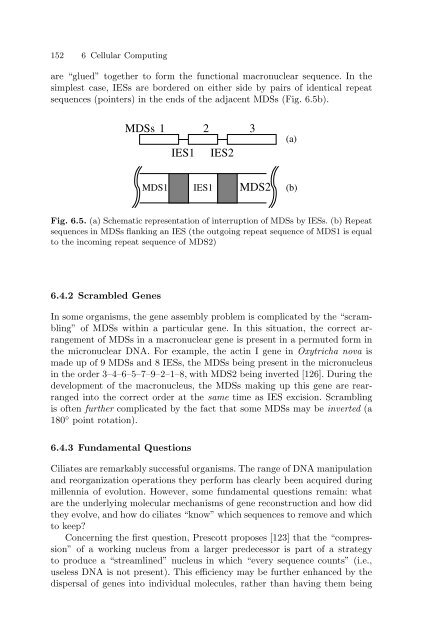Theoretical and Experimental DNA Computation (Natural ...
Theoretical and Experimental DNA Computation (Natural ...
Theoretical and Experimental DNA Computation (Natural ...
You also want an ePaper? Increase the reach of your titles
YUMPU automatically turns print PDFs into web optimized ePapers that Google loves.
152 6 Cellular Computing<br />
are “glued” together to form the functional macronuclear sequence. In the<br />
simplest case, IESs are bordered on either side by pairs of identical repeat<br />
sequences (pointers) in the ends of the adjacent MDSs (Fig. 6.5b).<br />
MDSs 1 2 3<br />
IES1 IES2<br />
MDS1 IES1 MDS2<br />
Fig. 6.5. (a) Schematic representation of interruption of MDSs by IESs. (b) Repeat<br />
sequences in MDSs flanking an IES (the outgoing repeat sequence of MDS1 is equal<br />
to the incoming repeat sequence of MDS2)<br />
6.4.2 Scrambled Genes<br />
In some organisms, the gene assembly problem is complicated by the “scrambling”<br />
of MDSs within a particular gene. In this situation, the correct arrangement<br />
of MDSs in a macronuclear gene is present in a permuted form in<br />
the micronuclear <strong>DNA</strong>. For example, the actin I gene in Oxytricha nova is<br />
made up of 9 MDSs <strong>and</strong> 8 IESs, the MDSs being present in the micronucleus<br />
in the order 3–4–6–5–7–9–2–1–8, with MDS2 being inverted [126]. During the<br />
development of the macronucleus, the MDSs making up this gene are rearranged<br />
into the correct order at the same time as IES excision. Scrambling<br />
is often further complicated by the fact that some MDSs may be inverted (a<br />
180 ◦ point rotation).<br />
6.4.3 Fundamental Questions<br />
Ciliates are remarkably successful organisms. The range of <strong>DNA</strong> manipulation<br />
<strong>and</strong> reorganization operations they perform has clearly been acquired during<br />
millennia of evolution. However, some fundamental questions remain: what<br />
are the underlying molecular mechanisms of gene reconstruction <strong>and</strong> how did<br />
they evolve, <strong>and</strong> how do ciliates “know” which sequences to remove <strong>and</strong> which<br />
to keep?<br />
Concerning the first question, Prescott proposes [123] that the “compression”<br />
of a working nucleus from a larger predecessor is part of a strategy<br />
to produce a “streamlined” nucleus in which “every sequence counts” (i.e.,<br />
useless <strong>DNA</strong> is not present). This efficiency may be further enhanced by the<br />
dispersal of genes into individual molecules, rather than having them being<br />
(a)<br />
(b)







